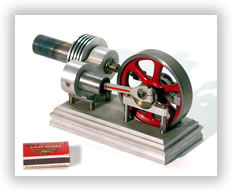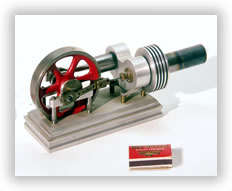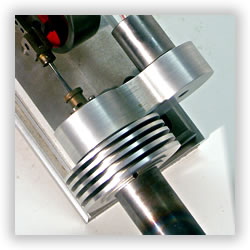
Above: right side view
Below: left side view

|
|
ENGINE NO. NINE DATA
Cylinders: 1
Type: Horizontal Stirling Cycle (external heat application)
Bore: 1.0”
Stroke: 1.625
Displacement: 1.28 cu in
Est. Max. RPM: 2,000
Est. Horsepower: 0.2
BUILDER'S
NOTES
Background -- The Stirling
or Hot Air Engine was patented in 1816 by Robert
Stirling, a Scottish clergyman. He called it a "heat
economizer."
I purchased the drawings from Coles Power Models and
built the unit from their drawings. The basic idea is that
Stirlings are supposed to convert any temperature difference
directly into movement. While there have been successful engines
of this type, they always have some inherent difficulty, such
as being quite large and heavy for the power they generate.
Every now and then someone re-discovers the Sterling principle
and while they have their uses, they don't really compete
with internal combustion engines.
Construction -- The construction of this model was pretty
straight forward but had to be pretty precise. It was fun to
build and makes a great display model.
Operation -- This model was
a non-operator: zero RPM. The energy source was heat applied
(via a torch) to what looks like an exhaust pipe in the photos.
You could see it trying, but I could never quite get it to
turn the crank. Quite disappointing. The basic problem seemed
to be that there was not enough contrast between the cooling
section and the heated section. Coles models gave a hint of
this when they suggested the engine could be modified by pressurizing
the air chamber to increase efficiency. Makes me think they
couldn't get it to work either. Well, you win some and you
lose some. So much for hot air.
|
|

Partial top view.
ENGINE DETAIL PAGE LINKS
(click on buttons)
|